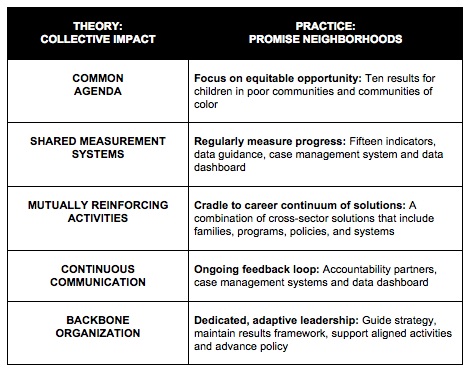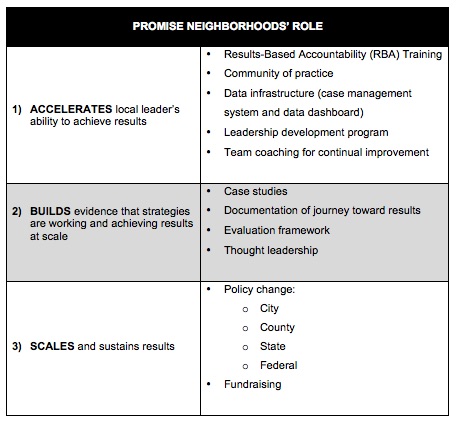Promise Neighborhoods: A Model for Collective Impact
 At this year’s SXSWEdu Conference, one of the most insightful sessions revealed a best-practice model for cradle-to-career collective impact, presented by Promise Neighborhoods Institute at PolicyLink.
Promise Neighborhoods is national, place-based program that seeks to create a comprehensive pipeline of educational and community supports to enable all children to reach their full potential. Its efforts in neighborhoods across the country wrap children in integrated, high-quality academic, social, and health programs and supports from the cradle to college to career.
At this year’s SXSWEdu Conference, one of the most insightful sessions revealed a best-practice model for cradle-to-career collective impact, presented by Promise Neighborhoods Institute at PolicyLink.
Promise Neighborhoods is national, place-based program that seeks to create a comprehensive pipeline of educational and community supports to enable all children to reach their full potential. Its efforts in neighborhoods across the country wrap children in integrated, high-quality academic, social, and health programs and supports from the cradle to college to career.
Every Promise Neighborhood relies on the following three factors in order to succeed: 1) strong schools, 2) family engagement, and 3) community engagement.
The Promise Neighborhoods approach is rooted in addressing the 16 million children living in poverty and the difficulty they face in their learning, health and development, and life success.
Putting Theory into Practice: Promise Neighborhoods

Promise Neighborhoods is explicit about what collective impact is not. In fact, a core philosophy is that “Collaboration is not a result.” By being cognizant of common traps of collaboration intent on large-scale change, Promise Neighborhoods ensures its communities are focused in the right areas and are equipped with effective strategies for moving forward.
Collaboration vs. Collective Impact
COLLABORATION TRAPS as noted by Promise Neighborhoods include:
- Desiring big results without aligning contributions
- Meetings, but no accountability
- Shared information, but no transformation
- Participating in conferences and webinars, but no results-driven action
- Writing reports without follow-through
- Short-term, programmatic results
COLLECTIVE IMPACT, on the other hand, requires:
- Taking on the toughest work
- Disciplined execution and silo-busting contributions
- A new level of accountability (specifically, using data for learning, continuous improvement, and shared accountability)
- Focus on large-scale, population-level results
Key Ingredients to Promise Neighborhoods’ Success
Following are the top 9 contributing factors that Promise Neighborhoods calls its “secret sauce” to achieving collective impact success in 60+ communities in the U.S. and abroad.
- Focus on 10 RESULTS that make a big difference for low-income children
- Measure progress on 15 INDICATORS against baselines
- Understand WHY INDICATORS ARE TRENDING in a particular direction
- Select PARTNERS for each indicator
- Work with partners to develop selection criteria and IDENTIFY SOLUTIONS for each indicator
- Entire team commits to POPULATION-LEVEL TARGETS by indicator
- Select a MIX OF SOLUTIONS for each indicator, including a) families, b) programs, c) policies, d) systems
- Identify partner targets and PERFORMANCE MEASURES, incorporate into action plans and begin implementation
- Develop PERFORMANCE CONTRACTS with partners (if applicable)
Role as Backbone Organization
Promise Neighborhoods' work as the backbone organization to collective impact efforts focuses in three key areas.

Key Competencies for Collective Impact Success
Promise Neighborhoods has outlined key competencies that are essential to effectively gain results for children at scale, from cradle to career.
- Business Planning: Develop a business plan
- Sustainable Financing: Create a financing plan
- Public Policy: Address policy and regulatory issues
- Pipeline of Services: Develop a multi-sector system of support using a mixture of solutions based in families, programs, policies, and systems
- Accountable Partnerships: Structure effective and accountable partnerships across systems
- Community Engagement: Meaningfully engage children, youth, families, and community stakeholders
- Constructive Conversations: Foster constructive dialogue about gender, race, class, culture, and systems change
- Use of Data: Use data for learning, continuous improvement and shared accountability
With many communities, including Fort Worth, seeking to create large-scale change to tackle complex issues like child poverty, education, and economic mobility, it is helpful to study what has worked well in collective impact frameworks across the country as we seek to adopt best practices locally.
For more information on Promise Neighborhoods, visit http://promiseneighborhoodsinstitute.org/about-the-institute. [1]
[1] Content has been adopted from Promise Neighborhoods’ materials. https://issuu.com/891011/docs/promising_neighborhoods_institute
